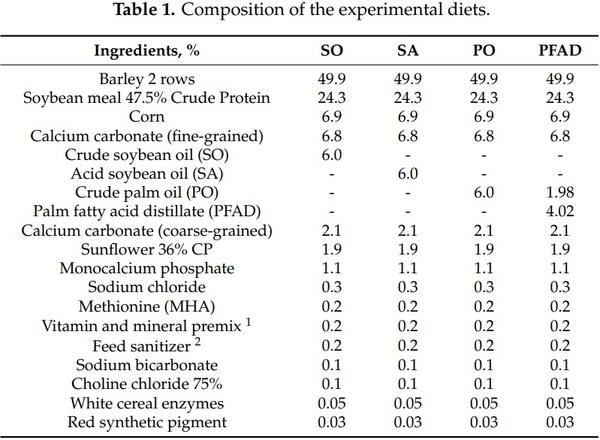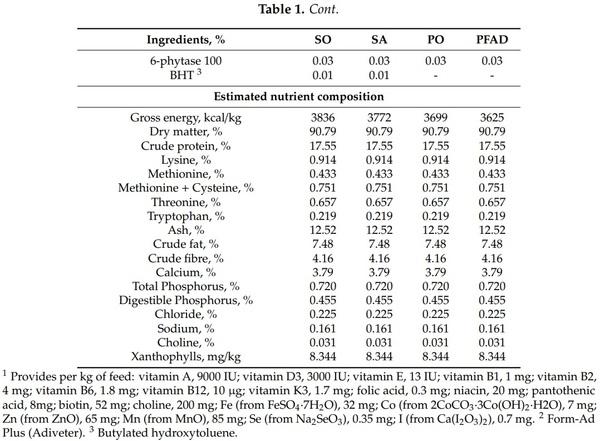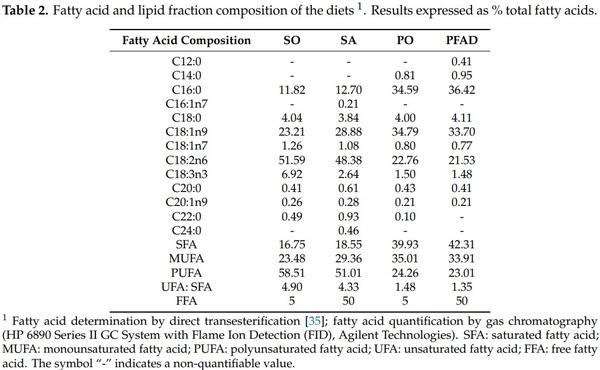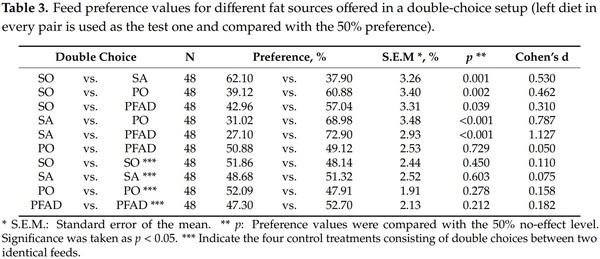Degree of Saturation and Free Fatty Acid Content of Fats Determine Dietary Preferences in Laying Hens
Author details:
Understanding fat sensing in chickens has the potential to improve least cost feed formulation relevant to poultry feeds. Acid oils (soybean acid oil and palm fatty acid distillate) are economical and sustainable feedstuffs with similar fatty acid composition to crude oils (soybean oil and palm oil) but richer in free fatty acids. However, potential issues relevant to the palatability of these oils have been raised. Four experimental diets were offered in a series of double-choice tests to study the effect of free fatty acid content and the unsaturated:saturated ratio on dietary preferences in hens. Hens showed a feed preference for palm oil added diets over soybean oil diets, with palm oil and palm fatty acid distillate being equally preferred. However, the hens demonstrated a preference for soybean oil when offered in choice with soybean acid oil. In conclusion, free fatty acid content and saturation degree affected feed preferences in hens. The use of oils with greater preference values may give rise to greater feed palatability, enhancing feed intake at critical stages.
Abstract: Behavioural and genetic evidence shows that the taste system is intimately related to the sensing of nutrients with consequences for poultry nutrition practices. A better understanding of how chickens may sense fat could provide the background for selecting feedstuffs used in poultry feeds. Acid oils have the potential to be economical and sustainable feedstuffs. These fat by-products from the edible oil refining industry possess a similar fatty acid composition to the crude oils but are richer in free fatty acids (FFA). An experiment was conducted to study the effect of FFA content and the unsaturated:saturated ratio (U:S) on dietary preferences in hens. Four fat sources were added to a basal diet at an inclusion rate of 6%, determining the experimental diets: soybean oil (SO; high U:S, 5% FFA); soybean acid oil (SA; high U:S, 50% FFA); palm oil (PO; low U:S, 5% FFA); and palm fatty acid distillate (PFAD; low U:S, 50% FFA). The experimental diets were offered in a series of double-choice tests to forty-eight Lohmann Brown laying hens housed individually in cages. Each hen was offered the ten potential binary combinations of the four diets including each diet compared to itself (referred to as four control double-choices). Feed intake was measured for two hours twice a day after one hour of fasting. Consumption was analysed as a standard preference index (% of test diet intake in comparison with the total intake). Preference values were compared to the random choice value of 50% using the Student’s t-test. None of the four control comparisons differ significantly from 50% (p > 0.05), indicating that the changes in preference values observed in the other binary comparisons were related to the dietary changes associated to fat ingredients. Hens showed a feed preference for palm oil added diets over soybean oil diets (p < 0.05), with PO and PFAD being equally preferred (p < 0.05). However, in this trial the hens demonstrated a preference for SO (low %FFA) when offered in choice with SA (high %FFA) (p < 0.05). These results suggest that the degree of saturation plays an important role in dietary fat preferences: hens prefer predominantly saturated oils even when these are rich in FFA. Furthermore, when presented with a choice between predominantly unsaturated oils, hens prefer feed with a low %FFA. In conclusion, %FFA and the U:S ratio affected feed preferences in hens. The use of oils with greater preference values may give rise to greater feed palatability, enhancing feed intake at critical stages.
Keywords: fat source; soybean oil; palm oil; laying hen; palatability; double-choice; preference.




1. Liu, H.X.; Rajapaksha, P.; Wang, Z.; Kramer, N.E.; Marshall, B.J. An Update on the Sense of Taste in Chickens:
A Better Developed System than Previously Appreciated. J. Nutr. Food Sci. 2018, 8, 686. [CrossRef] [PubMed]
2. Roura, E.; Foster, S.R. Nutrient-Sensing Biology in Mammals and Birds. Annu. Rev. Anim. Biosci. 2018, 6, 197–225.
[CrossRef] [PubMed]
3. Kassarov, L. Do cyanogenic glycosides and pyrrolizidine alkaloids provide some butterflies with a chemical defense against their bird predators? A different point of view. Behaviour 2001, 138, 45–67. [CrossRef]
4. Roura, E.; Baldwin, M.W.; Klasing, K.C. The avian taste system: Potential implications in poultry nutrition.
Anim. Feed Sci. Tech. 2013, 180, 1–9. [CrossRef]
5. Clark, L.; Hagelin, J.; Werner, S. The chemical senses in birds. In Sturkie’s Avian Physiology, 6th ed.; Scanes, C., Ed.;
Academic Press: Boston, MA, USA; Elsevier Inc.: Boston, MA, USA, 2014; pp. 89–111. Available online: https://digitalcommons.unl.edu/cgi/viewcontent.cgi?article=2612&context=icwdm_usdanwrc (accessed on
30 November 2020).
6. Niknafs, S.; Roura, E. Nutrient sensing, taste and feed intake in avian species. Nutr. Res. Rev. 2018, 31, 256–266.
[CrossRef]
7. Goff, S.A.; Klee, H.J. Plant Volatile Compounds: Sensory Cues for Health and Nutritional Value? Science
2006, 311, 815–819. [CrossRef]
8. Kalmendal, R.; Bessei, W. The preference for high-fiber feed in laying hens divergently selected on feather pecking. Poult. Sci. 2012, 91, 1785–1789. [CrossRef]
9. Forbes, J.M.; Shariatmadari, F.S. Diet selection for protein by poultry. World’s Poult. Sci. J. 1994, 50, 7–24.
[CrossRef]
10. Bouvarel, I.; Nys, Y.; Lescoat, P. Hen nutrition for sustained egg quality. In Improving the Safety and Quality of
Eggs and Egg Products, 1st ed.; Nys, Y., Bain, M., Van Immerseel, V., Eds.; Woodhead Publishing Limited:
Cambridge, UK, 2011; Volume 1, pp. 261–299. [CrossRef]
11. Forbes, J.M. Why did the chicken choose the food? In Proceedings of the 17th Australian Poultry Science
Symposium, Sydney, Australia, 7–9 February 2005; Poultry Research Foundation: Sydney, Australia, 2005; pp. 145–152.
12. Molnár, A.; Hamelin, C.; Delezie, E.; Nys, Y. Sequential and choice feeding in laying hens: Adapting nutrient supply to requirements during the egg formation cycle. World’s Poult. Sci. J. 2018, 74, 1–12. [CrossRef]
13. Mabayo, R.T.; Okumura, J.; Hirao, A.; Sugita, S.; Sugahara, K.; Furuse, M. The role of olfaction in oil preference in the chicken. Physiol. Behav. 1996, 59, 1185–1188. [CrossRef]
14. Bruce, E.H.; Prescott, N.B.; Wathes, C.M. Preferred food rewards for laying hens in behavioural experiments.
Br. Poult. Sci. 2003, 44, 345–349. [CrossRef] [PubMed]
15. Cheled-Shoval, S.L.; Reicher, N.; Niv, M.Y.; Uni, Z. Detecting thresholds for bitter, umami, and sweet tastants in broiler chicken using a 2-choice test method. Poult. Sci. 2017, 96, 2206–2218. [CrossRef] [PubMed]
16. Cartoni, C.; Yasumatsu, K.; Ohkuri, T.; Shigemura, N.; Yoshida, R.; Godinot, N.; Coutre, J.I.; Ninomiya, Y.;
Damak, S. Taste preference for fatty acids is mediated by GPR40 and GPR120. J. Neurosci. 2010, 30, 8376–8382.
[CrossRef]
17. Running, C.A.; Craig, B.A.; Mattes, R.D. Oleogustus: The Unique Taste of Fat. Chem. Senses 2015, 40, 507–516.
[CrossRef] [PubMed]
18. Meslin, C.; Desert, C.; Callebaut, I.; Djari, A.; Klopp, C.; Pitel, F.; Leroux, S.; Martin, P.; Froment, P.;
Guilbert, E.; et al. Expanding Duplication of Free Fatty Acid Receptor-2 (GPR43) Genes in the Chicken
Genome. Genome Biol. Evol. 2015, 7, 1332–1348. [CrossRef] [PubMed]
19. Sawamura, R.; Kawabata, Y.; Kawabata, F.; Nishimura, S.; Tabata, S. The role of G-protein-coupled receptor 120 in fatty acids sensing in chicken oral tissues. Biochem. Biophys. Res. Commun. 2015, 458, 387–391. [CrossRef]
20. Besnard, P.; Passilly-Degrace, P.; Khan, N.A. Taste of fat: A sixth taste modality? Physiol. Rev. 2016, 96, 151–176.
[CrossRef]
21. Rodriguez-Sanchez, R.; Tres, A.; Sala, R.; Garcés-Narro, C.; Guardiola, F.; Gasa, J.; Barroeta, A.C. Effects of dietary free fatty-acid content and saturation degree on lipid-class composition and fatty-acid digestibility along the gastrointestinal tract in broiler starter chickens. Poult. Sci. 2019, 98, 4929–4941. [CrossRef] [PubMed]
22. Nuchi, C.D.; Guardiola, F.; Bou, R.; Bondioli, P.; Della Bella, L.; Codony, R. Assessment of the levels of degradation in fat by-products for feed uses and their relationship with some lipid composition parameters.
J. Agric. Food Chem. 2009, 57, 1952–1959. [CrossRef] [PubMed]
23. Seabolt, B.S.; Heugten, E.; Kim, S.W.; Heugten, A.; Roura, E. Feed preferences and performance of nursery pigs fed diets containing various inclusion amounts and qualities of distillers coproducts and flavor. J. Anim. Sci.
2010, 88, 3725–3738. [CrossRef] [PubMed]
24. Uzu, G.; Picard, M.; Dunnington, E.A.; Siegel, P.B. Feed intake adjustments by hens to feeding regimens in which dietary methionine is varied. Poult. Sci. 1993, 72, 1656–1662. [CrossRef] [PubMed]
25. Zuberbuehler, C.A.; Messikommer, R.E.; Wenk, C. Choice Feeding of Selenium-Deficient Laying Hens Affects
Diet Selection, Selenium Intake and Body Weight. J. Nutr. 2002, 132, 3411–3417. [CrossRef] [PubMed]
26. Barkley, G.R.; Miller, H.M.; Forbes, J.M. The ability of laying hens to regulate phosphorus intake when offered two feeds containing different levels of phosphorus. Br. J. Nutr. 2004, 92, 233–240. [CrossRef] [PubMed]
27. Chagneau, A.M.; Bessonneau, D.; Bouchot, C.; Lescoat, P.; Picard, M.; Lessire, M. Broiler Short-Term Feed
Preferences Measured with SRAbox, a New Feed Choice Procedure. Poult. Sci. 2006, 85, 808–815. [CrossRef]
[PubMed]
28. Cerrate, S.; Coto, C.; Wang, Z.; Yan, F.; Costa, F.G.; Waldroup, P.W. Choice Feeding of Two Different Broiler
Strains Using Diets with Constant Energy Level. Int. J. Poult. Sci. 2008, 7, 726–737. [CrossRef]
29. Solà-Oriol, D.; Roura, E.; Torrallardona, D. Use of double-choice feeding to quantify feed ingredient preferences in pigs. Livest. Sci. 2009, 123, 129–137. [CrossRef]
30. Forbes, J.M. Palatability: Principles, methodology and practice for farm animals. CAB Rev. 2010, 5, 1–15.
[CrossRef]
31. Roura, E.; Navarro, M. Physiological and metabolic control of diet selection. Anim. Prod. Sci. 2018, 58, 613–626.
[CrossRef]
32. Yoshida, Y.; Kawabata, F.; Kawabata, Y.; Nishimura, S.; Tabata, S. Short-term perception of and conditioned taste aversion to umami taste, and oral expression patterns of umami taste receptors in chickens. Physiol
Behav. 2018, 191, 29–36. [CrossRef]
33. Directive 2010/63/EU of the European Parliament and of the Council of 22 September 2010 on the protection of animals used for scientific purposes. Off. J. Eur. Union L 2010, 276, 33–79. Available online: https://eur-lex. europa.eu/LexUriServ/LexUriServ.do?uri=OJ:L:2010:276:0033:0079:en:PDF (accessed on 30 November 2020).
34. FEDNA. Necesidades Nutricionales para Avicultura: Normas FEDNA, 2nd ed.; Fundación Española para el Desarrollo de la Nutrición Animal: Madrid, Spain, 2018; pp. 108–109. Available online: http://www. fundacionfedna.org/sites/default/files/NORMAS_FEDNA_AVES_2018v.pdf (accessed on 30 November 2020).
35. Sukhija, P.S.; Palmquist, D.L. Rapid method for determination of total fatty acid content and composition of feedstuffs and feces. J. Agric. Food Chem. 1988, 36, 1202–1206. [CrossRef]
36. Kim, J.-H. Diet Selection for Protein Quality by Growing Broiler Chickens. Int. J. Poult. Sci. 2014, 13, 461–466.
[CrossRef]
37. Cohen, J. Statistical Power Analysis for the Behavioral Sciences, 2nd ed.; Lawrence Erlbaum Associates: Hillsdale,
NJ, USA, 1988.
38. IBM Corp. IBM SPSS Statistics for Windows; Version 24.0; Released; IBM Corp.: Armonk, NY, USA, 2016.
39. Furuse, M.; Mabayo, R.T.; Choi, Y.H.; Denbow, D.M.; Okumura, J. Feeding behaviour in chickens given diets containing medium chain triglyceride. Br. Poult. Sci. 1993, 211–217. [CrossRef] [PubMed]
40. Furuse, M.; Mabayo, R.T.; Okumura, J. The role of gustation in oil preference in the chicken.
Jpn. Poult. Sci. 1996, 33, 256–260. Available online: https://www.jstage.jst.go.jp/article/jpsa1964/33/4/33_
4_256/_pdf (accessed on 30 November 2020).
41. Solà-Oriol, D.; Roura, E.; Torrallardona, D. Feed preference in pigs: Effect of selected protein, fat, and fiber sources at different inclusion rates. J. Anim. Sci. 2011, 89, 3219–3227. [CrossRef]
42. Dänicke, S.; Halle, I. Effects of iso-energetic low-fat feed, soybean oil or palm oil containing feed offered to laying hens, either separately or for self-selection, on feed intake, laying and reproductive performance and on egg quality. Landbauforschung Völkenrode 2002, 52, 239–247. Available online: https://literatur.thuenen.de/ digbib_extern/zi028458.pdf (accessed on 30 November 2020).
43. Klasing, K.C. Lipids. In Comparative Avian Nutrition; Klasing, K.C., Ed.; CAB International: Wallingford, UK,
1998; pp. 171–200.
44. Nielsen, B.L. On the interpretation of feeding behaviour measures and the use of feeding rate as an indicator of social constraint. Appl. Anim. Behav. Sci. 1999, 63, 79–91. [CrossRef]
45. Kyriazakis, I.; Tolkamp, B.J.; Emmans, G. Diet selection and animal state: An integrative framework.
Proc. Nutr. Soc. 1999, 58, 765–772. [CrossRef]
46. Waldburg-Zeil, C.G.; Staaveren, N.; Harlander-Matauschek, A. Do laying hens eat and forage in excreta from other hens? Animal 2018, 13, 367–373. [CrossRef]
47. Blavi, L.; Solà-Oriol, D.; Crespo, F.J.; Serra, M.M.; Pérez, J.F. The effects of including increasing doses of stevia and neohesperidine dihydrochalcone on feed preference in young piglets. J. Anim. Sci. 2016, 94, 138–141.
[CrossRef]
48. Steinruck, U.; Kirchgessner, M.; Roth, F.X. Selective methionine intake of broilers by changing the position of the diets. Arch. Geflugelkd. 1990, 54, 245–250.
49. Ettle, T.; Roth, F.X. Dietary selection for lysine by piglets at differing feeding regimen. Livest. Sci.
2009, 122, 259–263. [CrossRef]
50. Kim, H.J.; Min, D.B. Chemistry of Lipid Oxidation. In Food Lipids: Chemistry, Nutrition, and Biotechnology,
3rd ed.; Akoh, C.C., Min, D.B., Eds.; CRC Press: Boca Raton, FL, USA; Taylor & Francis Group: Boca Raton,
FL, USA, 2008; pp. 299–320. [CrossRef]
51. Frankel, E.N. Chemistry of autoxidation: Mechanism, products and flavor significance. In Flavor Chemistry of
Fats and Oils, 1st ed.; Min, D.B., Smouse, T.H., Eds.; American Oil Chemists’ Society: Champaign, IL, USA,
1985; pp. 1–37.
52. Erickson, M. Lipid Oxidation of Muscle Foods. In Food Lipids: Chemistry, Nutrition, and Biotechnology, 3rd ed.;
Akoh, C.C., Min, D.B., Eds.; CRC Press: Boca Raton, FL, USA; Taylor & Francis Group: Boca Raton, FL, USA,
2008; pp. 321–364. [CrossRef]
53. ISEO. Food, Fats and Oils, 10th ed.; Institute of Shortening and Edible Oils: Washington, DC, USA, 2016; pp. 19–21.
Available online: http://www.iseo.org/httpdocs/FoodFatsOils2016.pdf (accessed on 30 November 2020).
54. Smouse, T.H.; Chang, S.S. A systematic characterization of the reversion flavor of soybean oil. J. Am. Oil.
Chem. Soc. 1967, 44, 509–514. [CrossRef] [PubMed]
55. Miyashita, K.; Takagi, T. Study on the oxidative rate and prooxidant activity of free fatty acids. J. Am. Oil
Chem. Soc. 1986, 63, 1380–1384. [CrossRef]
56. Mistry, B.S.; Min, D.B. Effects of Fatty Acids on the Oxidative Stability of Soybean Oil. J. Food Sci. 1987, 52,
831–832. [CrossRef]
57. Choe, E. Effects and Mechanisms of Minor Compounds in Oil on Lipid Oxidation. In Food Lipids: Chemistry,
Nutrition, and Biotechnology, 3rd ed.; Akoh, C.C., Min, D.B., Eds.; CRC Press: Boca Raton, FL, USA; Taylor &
Francis Group: Boca Raton, FL, USA, 2008; pp. 449–474. [CrossRef]
58. Waraho, T.; McClements, D.J.; Decker, E.A. Impact of free fatty acid concentration and structure on lipid oxidation in oil-in-water emulsions. Food Chem. 2011, 129, 854–859. [CrossRef] [PubMed]















